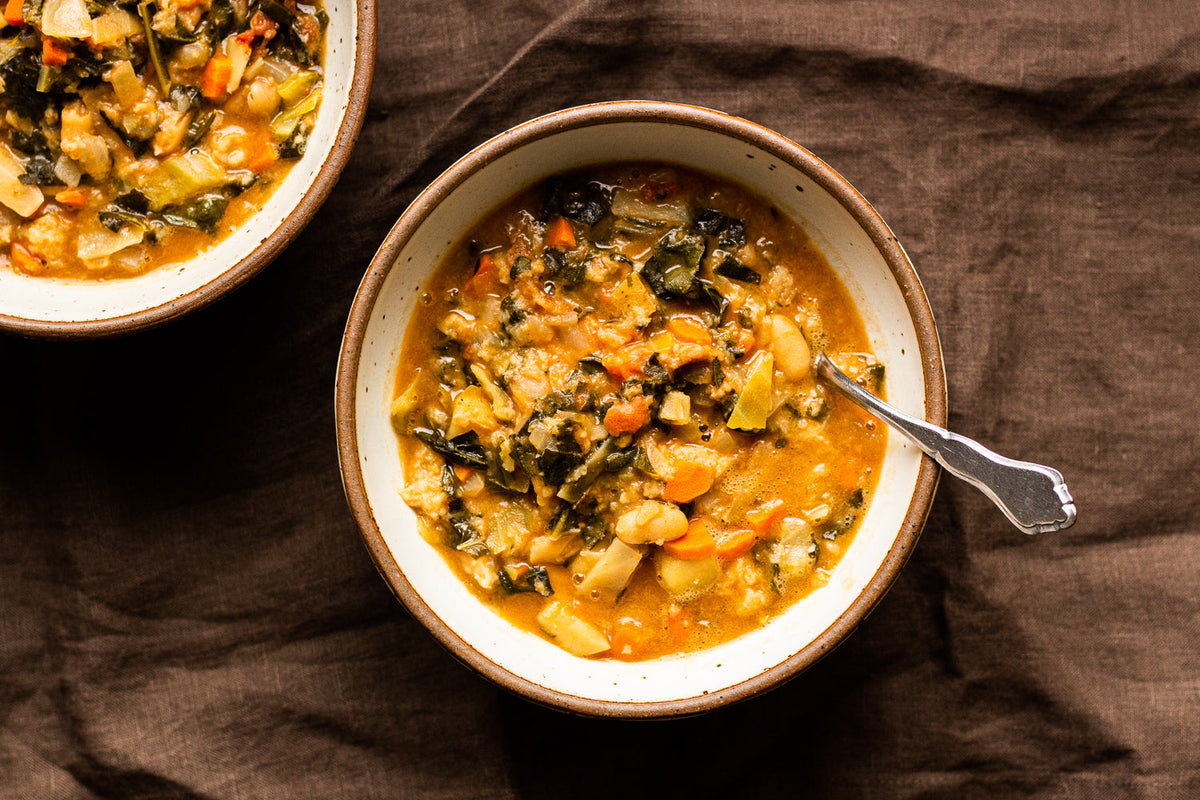
Ribollita
|
|
Time to read 3 min
|
|
Time to read 3 min
Ribollita is a classic Tuscan vegetable stew with three key components: lots of leafy vegetables, beans, and leftover bread. Simple, right?
Making ribollita certainly isn’t difficult, but like most Italian dishes, there is more to this recipe than meets the eye.
One might think that it’s easy to throw all the ingredients into a pot, cover it in broth, and let it boil for hours on end. And if that’s your style, all the more power to you. But in my opinion, the key to making a five-star ribollita is not only about the ingredients and the flavor they impart–it’s about texture, too.
When I think back to all the ribollitas I had while visiting Tuscany, the one thing they had in common was a balance between “the chunky” and “the smooth.” The vegetables weren’t just floating around in a bunch of broth, much like you might find with a chicken noodle soup. No, instead small bits of leafy greens, potatoes, and carrots were enveloped in this thick slop–a delicious slop, mind you–of mushy bread, beans, and broth.
So how does one achieve this not-too-chunky, mushy-yet-pleasant texture that ribollita dreams are made of?
After some experimenting in the kitchen, I think I’ve figured it out.
While you could dump in all the beans whole, I find that blending half of them together with a little bit broth before adding it to the rest of the stew creates a thicker, creamier broth consistency. It’s the little things.
Don’t skip this step! While I’m in full support of your paleo or keto diet, bread is one of those key ingredients that you simply can’t omit when making ribollita. Tear up the bread with your hands before adding it in, then let the whole thing simmer on low, while you stir and mash it up with a wooden spoon. You want the bread to become one with the liquid.
Meaning “reboiled,” ribollita is the kind of soup that only gets better with time. Prepare it a day or two ahead of time, letting it simmer all afternoon. Reheat it again and again throughout the week and see for yourself how the flavors and textures develop overtime.

20 minutes
90 minutes
8
Extra virgin olive oil, q.b.
1 large yellow onion, finely chopped
2 carrots, finely chopped
1 celery stalk, finely chopped
2-3 small potatoes, cubed
300 grams of stale bread (choose a thick, crust kind)
1 bunch of lacinato kale
¼ of green or white cabbage
1 bunch of chard
Fresh rosemary
Fresh thyme
1 (14-ounce) can of diced tomatoes
1 liter of vegetables broth
2 (15-ounce) cans of cannellini beans, drained and rinsed
1 parmesan or Grana Padano cheese rind
Salt, q.b.
Pepper, q.b.
In a large pot, add extra virgin olive oil and heat on medium. Add onions, celery, and carrot and sauté for a few minutes, just until softened. Add potatoes, kale, cabbage, and chard and cook for a few more minutes, until the leafy greens start to wilt.
Pluck the leaves from the rosemary and thyme sprigs, and finely chop. Add to the vegetables.
Add canned tomatoes and stir to coat the vegetables. Pour in broth until the vegetables are covered (add more water if needed) and then add the cheese rind. Season with salt and pepper. Cover and simmer on low for 30 minutes, or until the vegetables are soft.
Meanwhile, using an immersion blender or food processor, cream together one can of cannellini beans with a little bit of broth or water. Add pureed beans to the soup, along with another can of whole cannellini beans. Stir to combine.
Simmer for five more minutes. Taste and adjust the seasoning as needed.
Finally, tear the stale bread into cubes and add it to the soup. Simmer together until the bread starts to fall apart and thicken the rest of the soup. Discard the cheese rind before serving. Ladle into bowls and serve with a drizzle of extra virgin olive oil and freshly grated parmesan or grana padano cheese.
The flavors in this soup get better with time. In fact the name ribollitta means “reboiled.”